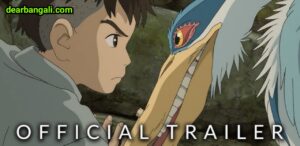The master animator from Japan, Hayao Miyazaki, returns from retirement with a new enchanted story.
With “The Boy and the Heron,” the contemplative and breathtaking masterpiece that he directed ten years prior, the Oscar-nominated “The Wind Rises,”
which the master of Japanese animation declared at the time would be his last feature film, Hayao Miyazaki faced an unsurmountable challenge.
It seemed as though Miyazaki’s 2013 film, which was a fictionalised account of Japanese aircraft designer Jiro Horikoshi’s life, was his last.

It addressed the complicated life of an artist as well as the accidental and purposeful effects of creativity.
If “Wind” represented Miyazaki’s farewell song, then “Heron” represents the elderly master returning to share one more exquisite, ethereal story.
The movie, which is set in World War II, centres on Mahito, a Japanese teenager who, following the death of his mother, moves from the city to the country with his father. Mahito,
who is having trouble adjusting to his new school, gets enthralled with a grey heron that lives by the river.
The boy sets off on his adventure into a magical world that exists just beneath the surface of our own.
A figure on the verge of transformation, Mahito embodies a quintessential Miyazaki character: a man trying to make sense of a strange and unfamiliar world. (Remember Chihiro from “Spirited Away,”
Mei and Satsuki from “My Neighbour Totoro,” and Howl from “Howl’s Moving Castle.”) Mahito appears in the film as a largely silent protagonist who lurks in the background,
taking in the action as a bystander. But as the story progresses, he evolves. Mahito never rises to the status of action hero, but his decisions have a lasting impact on both his world and the wider cosmos.
Story continues beneath the pop-up.
Even with Mahito’s occasionally sparse speech, we progressively gain a deep understanding of the character.
He picks a fight at school early in the movie because he feels out of place and lashes out. He later picks up a rock and slams it against the side of his head while walking home,
causing to flow out and cover his face. It’s startling, but it makes his hidden grief clear. The character gains a depth rarely seen in animated films at times like these.
(Soma Santoki’s voice acting in the Japanese version with subtitles emphasises this quality; there is also an English dubbing version available.)
“The Boy and the Heron” has a tone reminiscent of books like “Alice in Wonderland,” “The Chronicles of Narnia,” and “A Wrinkle in Time,”
in which the paranormal is lurking just past the fence and a short distance into the woods. Children with a little too much time on their hands engage in grand battles. The tale is a throwback,
showing a world with pirate ships, magic arrows, and a Parakeet King. The hero’s journey serves as a means of processing both personal and national pain, and in those stories, the fantastical also serves as a means of processing the real.
Here, there are also instances of genuine terror. This is a traditional fairy tale intended to terrify, perplex, and enthral rather than be a happy-go-lucky tale. It’s the kind of scary that helps kids get ready for the horrors of the real world—the good kind of scary.
“Heron,” like all of Miyazaki’s films, acts as a gateway, introducing young viewers to a pioneer of the animation medium as well as to foreign cinema.
(Do you recall a sleepover or rainy day when “Howl’s Moving Castle” or “Spirited Away” weren’t played?)
The composition and character design are audacious: the camera follows an arrow as it flies through the air, characters hunch in impossible contortions to depict the effect of age, and colours spill outside the lines to depict chaos.
The medium takes on fresh and thrilling twists as the movie moves towards its triumphant conclusion. Even at eighty-two, Miyazaki shows no signs of having run out of tricks.
Story continues beneath the pop-up.
It may sound harsh, but the movie is mediocre when compared to Miyazaki’s previous works.
There are moments of unquestionable ecstasy strewn throughout the movie, but the ending ultimately becomes a bit plotty. For Miyazaki, a film that would be considered a masterpiece by any other director is just another day at work.
Rumour has it that Miyazaki is already working on his next movie, even though he has repeatedly stated he would retire and then broken those promises.
However, “Heron’s” last scene feels as much like a conclusion as anything he has ever done. The film’s most enduring scene features a block tower collapsing, leaving it to be rebuilt by a new .
Whether or not this majestic, if flawed, movie marks the end of the world, Miyazaki leaves behind 12 films, some of which are unquestionably masterpieces, and that will always be impacted by his work.